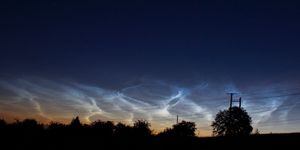Shropshire Sky At Night – July
Summer months are the time when hardened astronomers turn to tending their equipment, both old and new.

However, if we are not careful, we will miss out on some spectacular events. With Mars bowing out following close encounters with Venus and the moon, we search out other interesting objects and phenomena.
The king of the planets, Jupiter, is just a few weeks away from opposition, serving up an appetising feast of an ever-changing display. Approaching midnight, a small telescope (80mm class) will reveal a wealth of detail and features including the dynamic cloud tops together with the main dark belts.
A basic pair of 10 by 50 binoculars should reveal the motion of the Galilean moons but a larger telescope (greater than six inches) will be needed to observe the Great Red Spot.
The summer triangle is one of the best asterisms that inexperienced observers can locate, consisting of three of the brightest stars in the summer sky. Vega in the constellation of Lyra, Altair in Cygnus and Deneb in Aquila, can easily be pinpointed from light-polluted towns, and once identified, can be used as a signpost for further discoveries.
During July astronomical twilight commences about 11pm BST, with Vega, the principal star of Lyra, making its appearance high overhead when looking south, identifying the northwest corner of the triangle. Casual observers can be caught out by how large constellations and asterisms can be. Just be patient and persevere and you will reap the rewards.
Having identified Cygnus (the Swan), a dark site should reveal a plethora of stars streaming through the constellation. This is because we are looking towards the centre of our own galaxy, the Milky Way.
The Milky Way is a majestic sight as it sweeps up from the southern horizon about midnight and flows overhead towards the north. It is well worthwhile seeking out a dark site to observe this naked-eye wonder.
As your eyes become adapted you will be able to identify more detail and structure, and you should notice dark patches appear as silhouettes against the brightly sparkling stars that make up the plane of our galaxy. These dark patches are known as dark nebulae, consisting mainly of dust and gas, which conceal the light from the stars behind.
While truly dark nights have evaporated, the warm evenings bring with them a shimmering, shining phenomenon known as noctilucent clouds (NLCs), which appear for about three months around midsummer. They generally reveal themselves about the same time as the summer triangle, when the Sun dips between six degrees and 16 degrees below the horizon. They become observable due to the Sun reflecting off small ice articles present in the mesosphere (an altitude of about 80km), and bear a canny similarity to the beautiful cirrus clouds we see in the daytime sky.
One of their defining characteristics is the neon blue light as captured in the image taken over Baschurch last month. Modern digital cameras are perfect for NLC imaging, although any digital camera should produce a respectable image, so get snapping.
Steve Szwajkun is a Fellow of the Royal Astronomical Society





